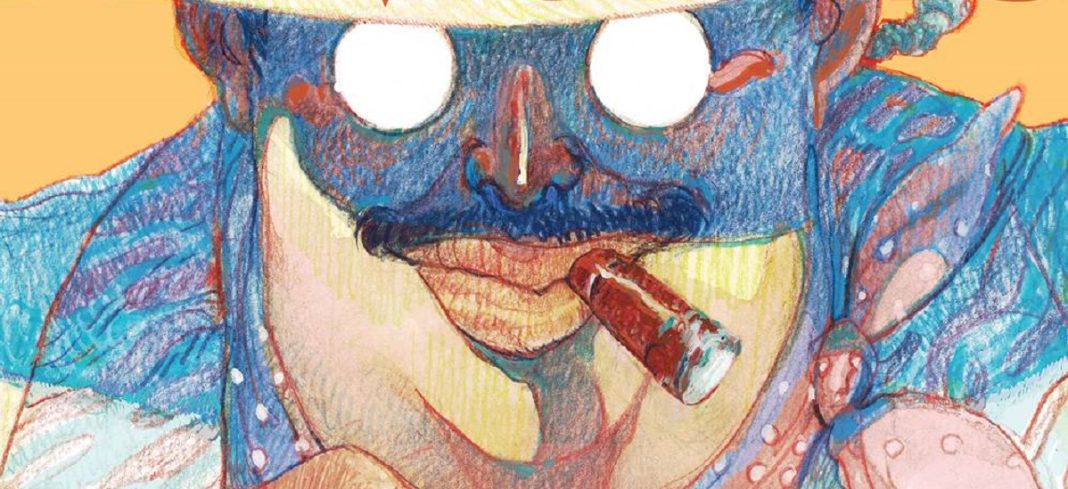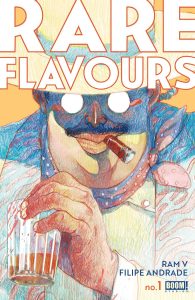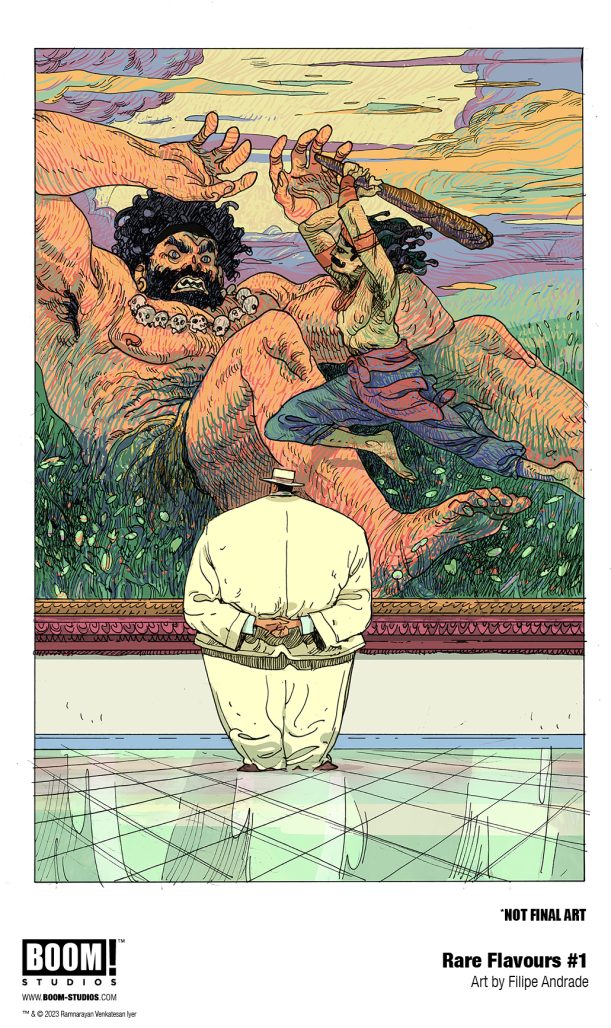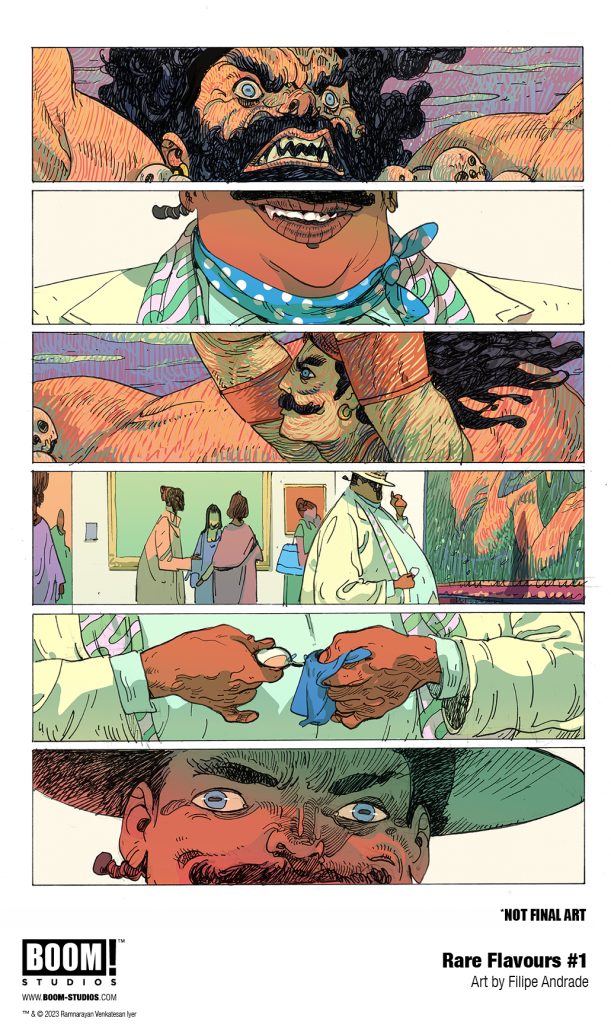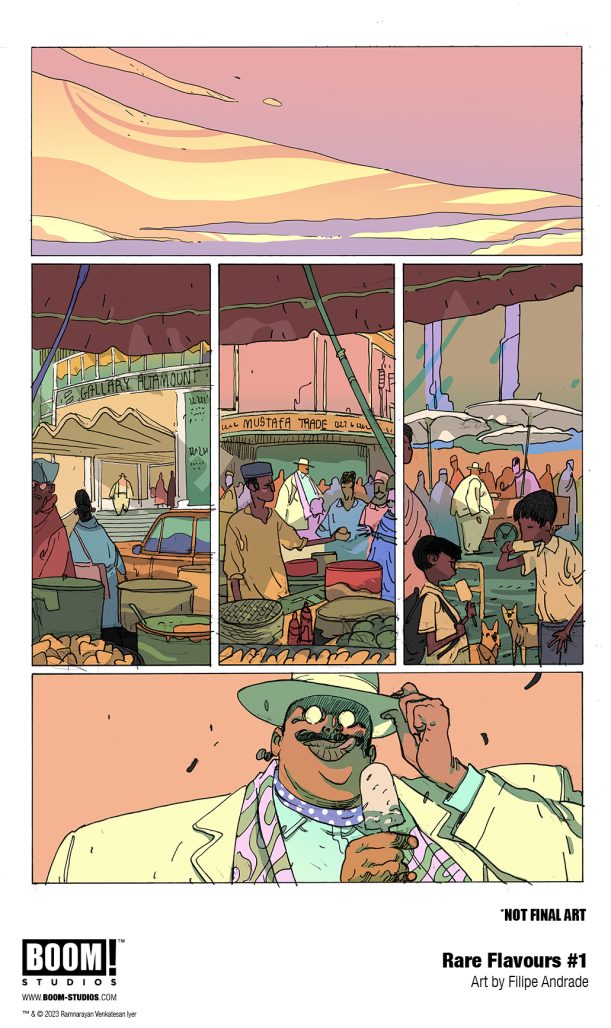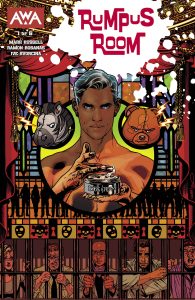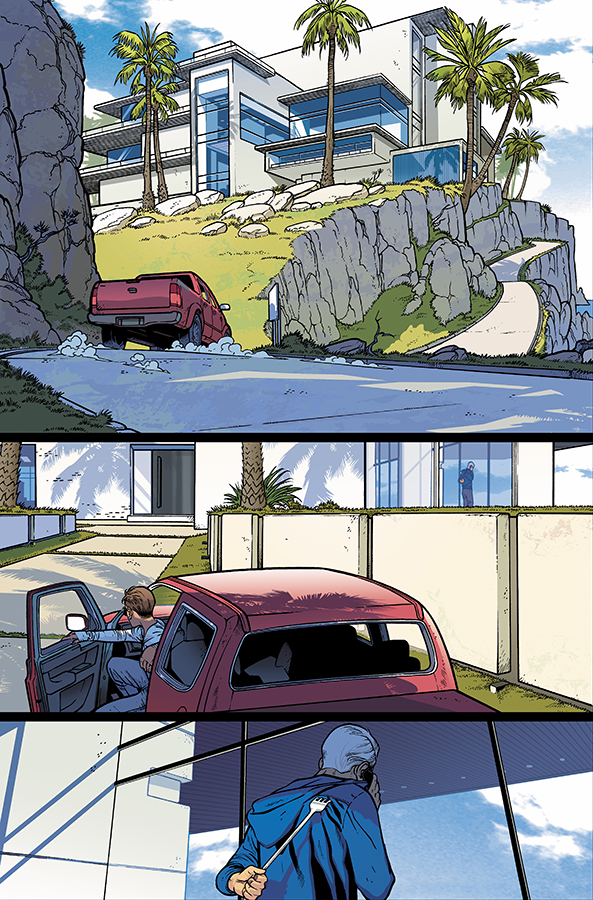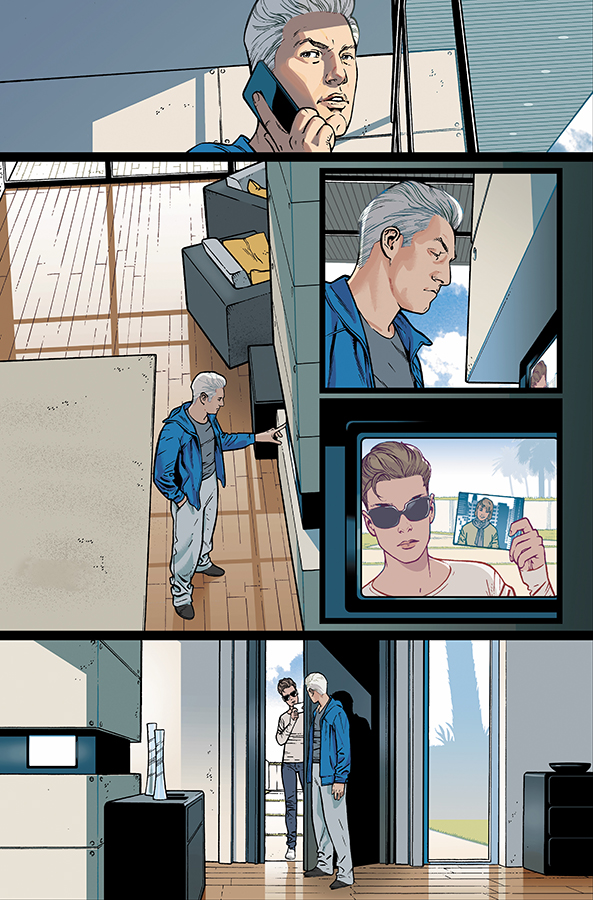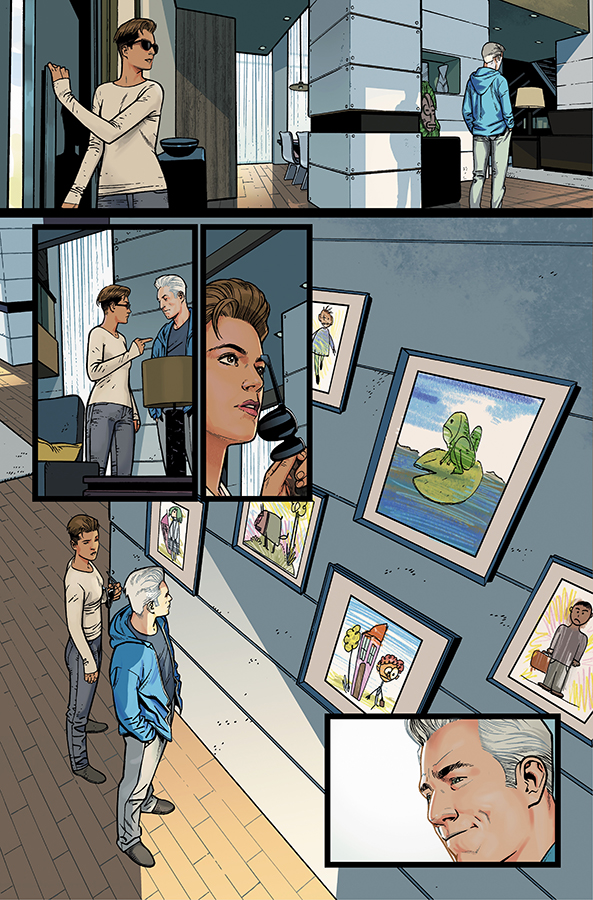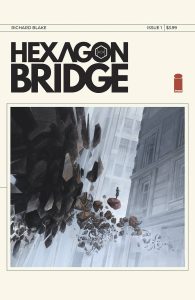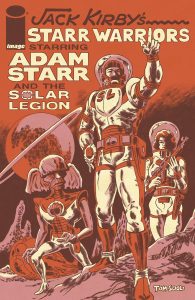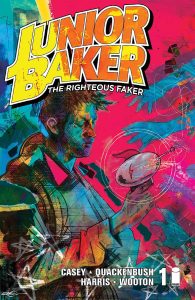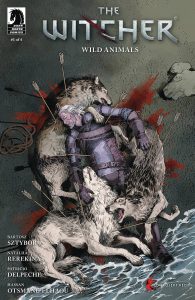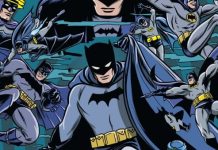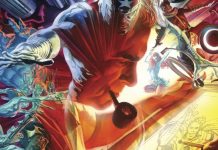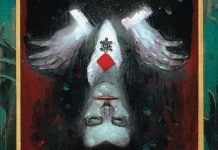This week’s main review is Rare Flavours #1, out now from AWA Studios. Plus, the Wednesday Comics Team has its usual rundown of the new #1s, finales and other notable issues from non-Big 2 publishers, all of which you can find below … enjoy!
 Rare Flavours #1
Rare Flavours #1
Written by: Ram V
Illustrated by: Filipe Andrade
Lettered by: AndWorld Design
Publisher: BOOM! Studios
Review by Cy Beltran
Rubin Baksh is a demon on Earth, haunting the streets of Mumbai to find great food and a documentarian to help him accomplish his dream of becoming the next Anthony Bourdain. If that doesn’t draw you in, you’re missing out.
This is the first title reuniting Ram V, Filipe Andrade, and AndWorld Design since The Many Deaths of Laila Starr, and if this opening issue is any indication, it’s another slam dunk so far.
Andrade creates such a vibrant world for us to live in. Every detail is lovingly rendered with a sense of intent, forming this squished city that begs to be touched. His figures have this liquid, mutable texture to them, and always feel animated to me, with the image pulled from the middle of its cycle. There’s one panel in particular, where a character’s arm ripples with incredible shockwaves after slamming into a table, that speaks to this aspect well.
V gives a far more sympathetic voice to Rubin than I would have expected, but it completely works to sell the story. Everything is told from his perspective, so while his actions may be monstrous at points, it’s possible to see why he’s so fascinated with humankind (even if he winds up using people as playthings). The issue gives us slight hints at this world, but V is great at leaving it at that, with those brief glimpses at a much larger story to hold us over.
There’s a gorgeous interlude at the midpoint of the issue that centers around the best way to brew a cup of Masala Chai, interspersed with details from the story of a man who once used that Chai recipe to build up and subsequently lose his way of life.
Andrade, who has been using a predominantly pastel palette, reverts to quieter, more muted hues for this scene. Combined with AndWorld’s switch to grounded lettering and V’s recipe for tea, it’s a totally distinct feel from the rest of the issue, one that brings us closer to humanity than our time spent with Rubin. It’s such a cool flex of the collective muscles of these creators, and speaks to just how good they are at what they do.
This is such a solid debut, and it’s going to be torture to wait month to month for this to keep coming out.
Verdict: BUY
 Rumpus Room
Rumpus Room
Writer: Mark Russell
Artist: Ramon Rosanas
Colorist: Ive Svorcina
Letterer: AndWorld Design
Publisher: AWA Studios
Review By Ricardo Serrano Denis
Mark Russell doesn’t give rich people a break, does he? Whether it’s showing how they create wealth-monitoring wristbands for exclusive access to tax free havens in Billionaire Island or how they essentially caused a robotic uprising through negligence in Not All Robots, job creators just can’t quite cut it in his books. Well, Russell’s at it again with a new series called Rumpus Room, a story that mixes a bit of Soylent Green with his own brand of satire to pull the curtain back once more on the sinister underpinnings of capitalism and its benefactors.
The story, illustrated by Ramón Rosanas and colored by Ive Svorcina, follows Erica Hernández, a woman in search of her missing sister. She goes straight to her sister’s last employeer, the obscenely rich Mr. Schrunk, with a pretty reliable suspicion he knows something about the disappearance. Schrunk oozes with the kind of privilege reserved for the one percent of the one percent, and it won’t take long for Erica to find out how ugly and dangerous that privilege can be.
Russell and Rosanas go dark for this one. Russell’s signature wit and satirical voice is there, a quality made even clearer thanks to Rosanas’ realistic approach to character stereotypes and caricature in his designs (Schrunk, for instance, looks like Jeffrey Epstein crossed with a tech bro and a hedge fund ghoul), but none of it is wacky or exaggerated. There’s a seriousness behind the situation that fosters dread rather than playfulness.
Several movies came to mind during my read of this first issue, most notably The People Under the Stairs (1991, dir. Wes Craven). Going too much into why it reminded me of this particular movie would spoil some of the great twists and turns the book has to offer, but it goes to show that its influences seem to also be hinting at a darker and bleaker take on the corrupting nature of greed. And that’s on top of the Soylent Green vibes one key aspect of the story brings out. Well read fans will find there’s a lot to look for between the lines and the gutters, subtle though many of these references tend to be.
Adding to the horror that drives Rumpus Room is the pacing, which is slower when compared to Russell’s other stories. Whereas books like The Flintstones, Not All Robots, and Second Coming go for a snappier sense of pace, Rumpus Room lingers on the terrible things Schrunk represents both literally and figuratively. I quickly got used to fact the villain here wasn’t going to respond to Erica with snotty remarks that pointed to his false sense of self-importance. Schrunk comes off as a very bad man, and the gravity of that is felt.
Much is owed to Rosanas’ ability to turn facial expressions into multidimensional manifestations of discrimination, disgust, tension, and utter disdain. They are so well done that you have no choice but to slow the reading down to engage with severe emotions coursing through the characters.
Svorcina’s colors accentuate this by keeping things excessively clean, as if dirt or grime are an impossibility in the world of the rich. The brightness and the pristine condition of it all unsettles the reader. It’s hard not to think of the people who were hired to keep everything looking perfect, and whether they were allowed to leave once they were done. Svorcina makes sure the point comes across with force, an impressive feat that speaks to the amount of storytelling colors can do.
All of this points to Rumpus Room doing something quite special: producing horror satire. It’s not an common thing to come across in the genre, mostly because horror already leans heavy on metaphor to turn its ghosts and goblins into not-so-subtle reflections of society. What Russell, Rosanas, and Svorcina are doing here is adding more layers to that, using horror as a vehicle to make satire more confrontational. You’ll laugh and you’ll have fun with Rumpus Room, but you will also feel a deep sense of unease once you finish the comic. You’ll think twice before going to a wealthy man’s mansion all alone.
Verdict: BUY
Wednesday Comics Reviews
Hexagon Bridge #1 (Image Comics): Writer and artist Richard Blake’s Hexagon Bridge #1 is an intriguing and visually stunning introduction to a new series. The layouts and quiet moments really work in creating a mood of mystery as we’re moved from one character to the next over the course of the story. The story plays thoughtfully as it sets up pieces around the bridge; a different dimension, a different space, where an expedition has gone wrong. The shape language works well with the lettering though thematically with what we find out, I think that it works a bit stronger in the bridge than outside of it because of the balloon shapes being consistent across both dimensions. In the bridge, Blake gets to play with constructing and deconstructing space in a way that traps the eye in a panel and doesn’t let go. This happens across the sequences in the bridge and it’s truly a treat to look at. This whole first issue is a visual treat as Blake breaks up sequences by introducing a new character, almost like a new chapter. The linework is gorgeous from the characters to the environments, giving detail after detail to capture the eye as the reader is moved from panel to panel. The mystery of the characters and what the hexagon bridge is sets up intrigue and a solid hook for what comes next. –Khalid Johnson
Jack Kirby’s Starr Warriors: The Adventures of Adam Starr and the Solar Legion (Image Comics): A man plants a foot in a new frontier. That man? Tom Scioli. The frontier? Solar Legion with Adam Starr! Going backwards an eternity, a similar man, a similar frontier: Jack Kirby pens his first pages for a going-extinct pre-war publisher. These are those pages. Brought to you for $10 USD, Scioli remixes the entirety of Kirby’s Solar Legion to be reborn anew in 2023 with less color, more pages, and some light editorializing. Scioli redraws panels and letters, but reorients panels, siloes panels for impact, and splits 6-panels into multiple pages, enlarging or widening where needed. It’s fascinating to compare and contrast the two and how different they read when condensed or expanded upon. A major change from the pages of Crash Comics Adventures, Adam Starr’s first resting place, is Scioli’s simplified color palette. Consisting of creme, burnt umber, and persimmon, Scioli casts light where there was none, reigns in some of Kirby’s value fluctuations, and brightens Adam Starr’s explosions in the process. With a graphite smear, Scioli’s inks recall Kirby’s early shading with accuracy and nostalgia. If, fellow earth person, you want to venture towards eternity with this work in hand, you may do so at your earliest convenience! —Beau Q.
Junior Baker: Righteous Faker #1 (Image Comics): This Image series from writer Joe Casey, artist Ryan Quackenbush, and letterer Rus Wooton is a detective story set in a grounded but unraveling world of superheroes and magic. Technically a sequel series to a 12-year-old comic, this book is very much a standalone story and accessible without being familiar with the last Baker story. But just describing this book by its genre trappings sells it short. It is a cerebral, introspective look at a complex lead character, with stunning, abstract expressionist art by Quackenbush. The loose and tactile style gives the book a sense of the ethereal and grandiose, perfect for Casey’s exploration of reality, meaning, and justice, and the arbitrary social constructs that define our lives. It’s an exciting, surreal first issue with a compelling lead. —Tim Rooney
-
The Witcher: Wild Animals #1 (Dark Horse Comics): Issue one of the Witcher, Geralt of Rivia’s newest comic adventure, has the monster hunter go through quite the ringer on his latest job with all not being as it seems. He’s to assist in the solving of a most unusual murder. Written by Bartosz Sztybor, the issue leads off the story strong with a fair number of twists and rough seas for Geralt that many will be used to if they’re a fan of the video game series and the many side-quests players find themselves sucked into while doing something completely different! Art from Nataliia Rerekina shows us a wide variety of well-drawn settings from the open seas to dark forest filled with dangerous mysteries. Colors by Patricio Delpeche with assists from Agustina Vallejo help in bringing these settings to life with proper warmth, cold, and life. Lettering from Hassan Otsmane-Elhaou gives the proper voice to everyone on page. From Geralt’s gruff, short responses, to the highly accented Skellige inhabitant. In true Witcher fashion, this story promises there is more than meets the eye and Geralt will have quite the task ahead of him trying to tell who the true monsters are that need slaying. —Bryan Reheil
Read more entries in the Wednesday Comics reviews series!


